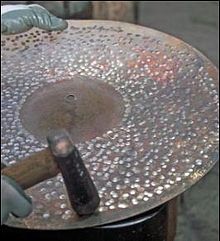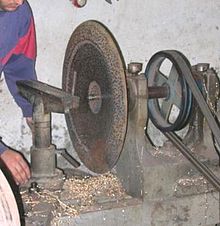- Cymbal making
-
Modern cymbal making uses many different techniques, from traditional hand methods to completely automated mass-production.
Contents
The traditional process
Historically, cymbals were made from individually cast cymbal blanks which were then hot-forged, often with many annealing processes, to form the rough shape of the cymbal.
The finishing stages consisted of cold-hammering to unevenly harden the metal, then turning on a lathe to reduce the thickness, and then often a final cold hammering.
The hot and cold hammering were all performed entirely by a highly skilled hand and was a labour-intensive process. The only machine to touch the cymbal was a hand-held lathe.
This lathing step could decrease the weight of the cymbal by two-thirds or more, and resulted in further uneven hardening which produces much of the tone of a traditionally made cymbal. This effect was deliberately enhanced by use of a coarse lathe tool, and sometimes by a very limited final polishing, leaving the lathe tool marks as "tone grooves". Traditional cymbals are lathed over the entire surface top and bottom.
Modern developments
Each stage of this process has been modified by the use of recent technology.
One of the main effects has been that far closer manufacturing tolerances can be achieved, resulting in more consistent sounding cymbals.
This has also provided the opportunity to omit some of the traditional steps completely, and so unlathed, partly lathed, and even unhammered cymbals have entered the catalogs of major makers, and achieved widespread acceptance.
Casting techniques
Two modern techniques now provide an alternative to the traditional casting technique.
Rotocasting
The more unusual of these is rotocasting, in which the mold is spun to force metal into the details of the mold by centrifugal force. This allows the hot forging step to be reduced or even omitted, as the resulting casting can be made far closer to the final shape of the cymbal, including its bell and taper. It is an expensive process used for a few top quality bell bronze cymbals.
Sheet metal cymbals
Many modern cymbals are stamped from sheet metal. Since only malleable alloys can be cold rolled into sheets, there is no commercially available bell bronze in sheet form, but cymbals of all other common cymbal alloys have been produced in this way.
Some claim that these "sheet" cymbals have a different sound to traditionally made cymbals, owing to their manufacture from sheet metal rather than from individual castings. Others claim that the larger difference is the alloy or the hammering technique. Top quality "cast" cymbals are normally made from bell bronze, while "sheet" cymbals are normally made from malleable alloys.
The major manufacturer Paiste even claims that the division into cast and sheet cymbals is misleading, as all alloys are at some stage cast, and refuses to say whether or not particular cymbals are made from sheet metal. Their Sound Alloy patent implies that they have a method for making sheet metal cymbals of this alloy, which would make these a unique third category.
The 2002 Paiste Cymbal Guide even claims that all cymbals are "cast", not just their own, but here they are not using the word in the established sense. All other manufacturers openly state that all of their malleable alloy cymbals are made from sheet metal, and that all of their bell bronze cymbals are individually cast. One possible reason for Paiste's claims is that there is still a great deal of prestige associated with traditionally cast cymbals. The first sheet cymbals were brass, and were very cheaply made. It is only in the last few decades that top-quality sheet cymbals have been produced at all.
But whether this prestige is still deserved is doubtful. The major manufacturer Meinl produces both cast and sheet cymbals, and currently chooses to make their top premium line from sheet bronze. Some top drummers who play Zildjian or Sabian cymbals now choose to play their sheet bronze cymbals, rather than their more expensive cast cymbals, for the sake of their sound.
Louder drummers tend to choose sheet cymbals, while jazz players and major orchestras still tend towards cast cymbals. So it is more a matter of choosing the correct cymbal for the sound required.
Forging techniques
Some manufacturers of bell bronze cymbals now use hot-rolling and cold-pressing of individual cymbal blanks rather than traditional forging. These processes are faster and cheaper and appear to have little if any effect on the final sound.
Hammering techniques
This is another controversial subject. Many manufacturers claim that their cymbals are "hand hammered", but again these words may not always mean the same thing.*
Some hand hammered cymbals are hammered using a hammer held in the cymbalsmith's hand. Others are hammered using a proprietary machine, but are still described as "hand hammered" because the hammering is under the control of an individual craftsman. Many drummers are angered when they realize that their hand hammered cymbals aren't actually hand hammered.
In general, truly hand hammered cymbals tend to have darker, lower, richer tones, and there tends to be far more variation in character between cymbals of supposedly identical models. Istanbul Agop Cymbals are good examples of traditionally hand hammered cymbals.
Conversely, cymbals hammered by automated machines tend to be brighter, higher in pitch, and more cutting. Most significantly, the variation between supposedly identical cymbals is noticeably reduced, assuming adequate quality control.
The difference in sound is due mostly to the nature of the hammering: hand hammering is done randomly (that is not in a regular pattern) and thus the cymbal has a darker sound-even if this "random" style is dictated and executed by a computer. Symmetrical hammering- which is almost always done by a machine- gives the cymbal a brighter sound. So it is random hammering versus symmetrical hammering that accounts for the major discrepancies between the sounds of various cymbals. This fact is reinforced by the example of some cymbals from English independent cymbal maker, Matt Nolan, which are unusual in being truly hand hammered but made from Malleable Bronze. The results are darker sounds from what are normally considered brighter alloys.
Turning (Lathing)
There are three significant modern developments here.
Firstly, the lathe itself underwent enormous development during the 20th century. Some cymbal lathes are now automated.
Secondly, the closer tolerances have led to far more use of unturned and partly unturned cymbals. The turning which was once essential to form the shape of the cymbal can now be varied to produce new sounds, especially at the top end of the range.
One pioneering example was the Meinl Raker splash, whose top surface has a single spiral cut by a single pass of a very coarse tool. Another is the Zildjian Earth Ride, whose top surface is not turned at all, but very sparingly hammered. Many manufacturers now produce cymbals with one or both surfaces unturned, or with bands of dark unturned metal. Modern coarse turning patterns allow unturned metal and hammering-marks to show through between the tracks of the lathe tool.
Thirdly, at the opposite end of the cost spectrum, some cheaper cymbals are not turned at all but have obvious (generally rather coarse) sound grooves. These have been produced by pressing rather than turning. The effect on the sound is similar to turning, because the parts of the metal that have been most deformed are most hardened. However the effect that can be produced in this way is very limited.
In the extreme it is even possible to produce a cymbal that appears to have been turned then hammered, by a single operation of a press starting with a flat metal sheet. The result is a round cymbal, with a thickened bell, tapered bow, turning marks and hammering marks. In large numbers these are very cheap to make but the results reflect it.
Away from this extreme, the line between hammering and pressing can blur. Some excellent student cymbals have a final hammering pattern produced by a single blow of a press, after genuine turning. The effect on the metal of this pressing operation is very similar to the effect of machine hammering, and the results are very consistent.
Polishing
Modern cymbals are available in several polishes or finishes.
Traditional fully lathed cymbals were simply bare metal all over, and were allowed to tarnish with time. This finish is still the most common.
The first departure from this was the appearance of "bright" or "brilliant" finishes. These are the result of abrasive polishing. Some metal is removed in the process, but the effect is mainly visual.
In the case of bands of oxide left on partly lathed cymbals like the Bosphorus Ferrit Antique and Istanbul Custom Sultan it is impossible to decide what the contribution of the oxide pattern is to the sound, as these tend to be complex, top-quality handmade cymbals. But in giving the cymbal designer more options, they allow more precise and focused control, and production of a wide range of sounds.
Finally, on some cymbals the oxide coat is deliberately enhanced to simulate age, or a whole new coating applied. Examples are Meinl Champagne Finish, Masterwork Avanos and Paiste Coloursound. Results depend very much on the actual coating and the cymbal.
See also
- Istanbul Agop Cymbals
- Sabian Cymbals
- Matt Nolan Custom Cymbals
- Saluda Cymbals
- link Zildjian Cymbals
- Cymbal alloys
External links
- Videos of the process used by Masterwork cymbals (German and Dutch language website).
- A description of the traditional process used by Bosphorus cymbals, with photos.
- A brief story of cymbal making history by Istanbul Agop Cymbals.
Categories:- Cymbals
- Manufacturing
Wikimedia Foundation. 2010.


